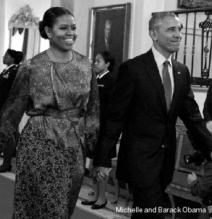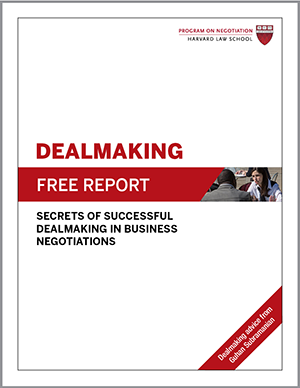
Creative negotiation involves thinking outside the box—seeing the broader possibilities available beyond conventional practice. It’s perhaps no surprise, then, that industry outsiders often are best positioned to negotiate creatively because they are less familiar with “how things are done.”
After Barack and Michelle Obama left the White House in 2017, they hired lawyer Robert Barnett to sell their memoirs of their time as president and first lady. Barnett’s “outsider” status in publishing may help to explain his creative negotiation and auction moves on their behalf.
Following the Script
Far from a traditional New York publishing agent, Barnett is a Washington, D.C., lawyer who has fostered a healthy “side business,” as he calls it, representing politicians in their book auctions and negotiations with publishers, writes Harvard Business School and Harvard Law School professor Guhan Subramanian in his book Dealmaking: The New Strategy of Negotiauctions. Luminaries on Barnett’s client list include Bill and Hillary Clinton, George W. and Laura Bush, and U.S. senators. Rather than charging his clients 15% of their earnings, as most literary agents do, Barnett bills by the hour, an arrangement that can save his clients considerable money.
Barnett has an established process that he follows with his book clients, writes Subramanian. First, he accompanies them on a tour of major New York publishers to describe the book. Next, he sends editors a letter describing the rules of his auction. Barnett instructs them to submit a detailed offer in writing by a certain date, which should include information about the advance, a payment schedule, royalty levels, and advertising and promotion commitments. He also explains how the auction will unfold: “On [date], I will call the low offeror and ask if he/she will top the high offeror. That process will continue for as long as necessary.” It’s a simple, straightforward auction process.
Rising Action
Executives at top publishing houses met separately with the Obamas in February 2017, according to the New York Times. Interest was likely at a fever pitch. Memoirs by departing presidents typically sell very well, and Barack Obama’s two previously published memoirs were runaway bestsellers.
Early in the negotiation process, it appeared that Barnett, working with his colleague Deneen C. Howell, was going to auction the Obamas’ books separately. At some point, however, the two books were combined into one deal, according to the Times.
The prospect of a joint book deal “propelled the auction to record-breaking levels and has set the publishing industry alight,” according to the Financial Times. HarperCollins, Simon & Schuster, and Penguin Random House reportedly all competed with opening offers for the two books (combined) in the $18 million to $20 million range.
On February 28, the news broke that Penguin Random House was the winning bidder, with a staggering offer of $65 million. Even with the sum divided between the two books, it was a record-breaking deal for a presidential memoir, according to the Financial Times.
Was the Winner Cursed?
The Obamas’ choice of publisher was not a shock, given that Penguin Random House published the couple’s previous four books, but the size of the bid raised eyebrows. Could the publisher recoup such a staggering advance? Or would Penguin Random House be a victim of the “winner’s curse”—the tendency for the winning bidder in an auction to overestimate the commodity’s value?
The deal appears to have been a good bet. The first volume of the former president’s memoir, A Promised Land (published in 2020) and the former first lady’s 2018 memoir, Becoming, sold a combined 25 million copies by 2022 and are expected to sell strongly for years to come, according to Vox. As the former president presumably works on the next volume of his memoir, Michelle Obama has gone on to publish another best-selling book with Penguin Random House, The Light We Carry: Overcoming in Uncertain Times.
3 Guidelines for Creative Negotiation:
- Question convention. The decision to auction the two books as a package was a creative negotiation that capitalized on the popularity of the Obamas as individuals and as a couple. Combining two or more linked negotiations has the ability to enhance your bargaining power in negotiations by generating a buzz that drives up the price.
- Try a “negotiauction.” Barnett favors a negotiation-auction hybrid process—dubbed a negotiauction by Subramanian—in which he and his client(s) negotiate individually with publishers to assess interest and compatibility before holding an auction on price. With negotiauctions, you often can get the best of both worlds: negotiation across multiple issues and the price competition of an auction.
- Beware the winner’s curse. Because the highest bidder in an auction often pays more than the commodity is worth, be sure to craft your bid with care. This is especially important when the commodity for sale has a similar value to all bidders rather than having unique value to you.
What other creative negotiation strategies have you observed or participated in lately?





